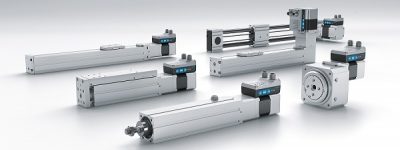Pack Expo Preview: Festo Corporation

Festo features its innovative Simplified Motion Series (SMS) at Pack Expo, September 27-29, Las Vegas, Booth #6132. New in 2021 for these all-in-one integrated-drive axes is IO-Link control that can be used for cost-effective, multi-position applications.
SMS represents an engineering breakthrough that combines the simplicity of pneumatics with the benefits of electric automation. SMS takes proven ball screw axes, toothed belt axes, mini slides, electric cylinders, piston rod, and rotary actuators and integrates them with an onboard servo drive. Users commission two-position functionality via onboard push buttons with no additional software needed.
When controlled with IO-Link, which is a standard feature of SMS axes, positioning along the axis length is infinitely variable. When used like this, SMS axes offer a cost-effective alternative to more expensive and complex traditional servo motion. Low cost when compared to traditional servo motion solutions and setup as simple as pneumatics opens the door to applications that have previously been cost prohibited to electrics, including conveyor material handling, and applying electric motion in mobile applications.
Via IO-Link, technicians can remotely adjust movement parameters, including infinitely variable positions and speed. They can also copy and backup functions for parameter transfer and read functions of essential process parameters.
A greater look inside SMS
SMS actuators are applied in positioning, indexing, clamping, feeding, and cut-to-length tasks where electric automation adds proficiencies and value. Ordering, inventory, and replacement are streamlined as all of the components are integrated into a single unit with a unique part number. Units in the series include: ELGS-BS ball screw, ELGS-TB toothed belt axis, EGSS mini slide, EPCS electric cylinder, EPCE compact electric cylinder, ERMS rotary drive, and ELGE toothed belt axis.
Festo used 50 years of knowledge in simple motion based on pneumatics and applied it to electric motion for an equivalent level of ease of use. SMS opens the door to creative new solutions that benefit from the flexibility of low-cost and easy-to-commission electric motion.
Both Digital I/O (DIO) and IO-Link control come standard with each unit. With DIO control, there are two positions available – home and a configurable end point. As stated above, IO-Link offers flexible positioning along the axis, like a traditional electromechanical axis.
PLC set up for DIO control is identical to programing a digital pneumatic valve with two digital outputs and two digital inputs. One digital output extends the axis and the other retracts it. And the digital inputs indicate when the axis has reached the extended position or the retracted position, just like proximity switches would function on a pneumatic actuator. This similarity to a pneumatic valve simplifies PLC programming, reduces the number of I/O typically required for servo-controlled motion, and speeds up installation of single and multiple units. Integrated position feedback eliminates the need for proximity sensors.
Since the electronic components and modules are onboard the integrated drive, these actuators are machine mountable. There is no external servo drive to mount in the control panel, which means minimal control panel overhead associated with these electric drives.
Festo wanted to maintain the similarity between simple electric motion and pneumatics, so software is not required for teaching movement. Commissioning is based on pushbuttons located on the drive. Key commissioning parameters include:
•Speed for the extend (“out”) and retract (“in”) movement
•Force of the axis in the “out” position
•Setting the reference end position
•Teaching the position for the start of force-controlled movement
•Demo mode, which can be used to test the movements from the keypad
The SMS axes offer motion characteristics that simplify commissioning for gentle cushion retraction, press-fitting, and clamping functions. Simple electrical connection is accomplished via a M12 plug design with 4-pin power and 8-pin logic.
With this new series of electric actuators, engineers can now choose between pneumatic or electric actuation for their machine and have a basic equivalency in terms of cost and installation overhead. Each type of actuation offers its own motion and force profiles, as well as other operational factors, giving engineers a broader set of solutions to apply to their design challenges. In terms of simple linear and rotary motion capabilities, the new Simplified Motion Series axes represent an important opportunity for original equipment manufacturers.





